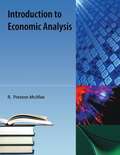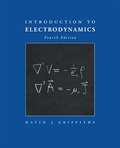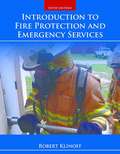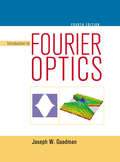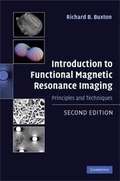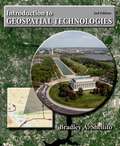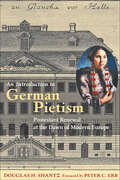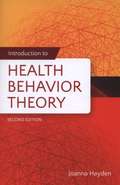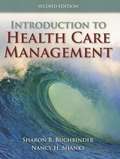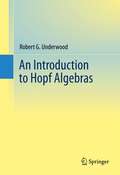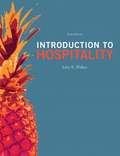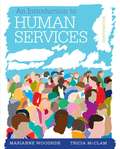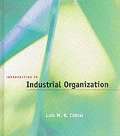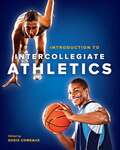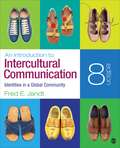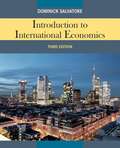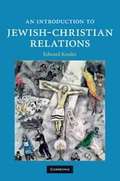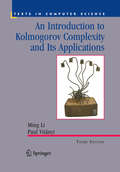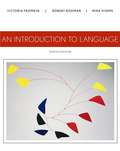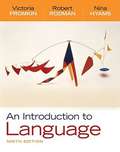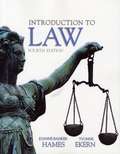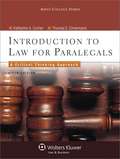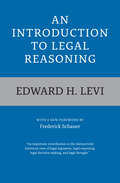- Table View
- List View
Introduction to Economic Analysis
by R. Preston Mcafee Tracy R. LewisThis book presents standard intermediate microeconomics material and some material that, in the authors' view, ought to be standard but is not. Introductory economics material is integrated. Standard mathematical tools, including calculus, are used throughout. The book easily serves as an intermediate microeconomics text, and can be used for a relatively sophisticated undergraduate who has not taken a basic university course in economics. The focus of this book is on the conceptual tools and not on fluff. As such, it reflects the approach actually adopted by the majority of economists for understanding economic activity. There are lots of models and equations, and no pictures of economists ;-) Economic analysis is used in many situations. When British Petroleum sets the price for Alaskan crude oil, it uses an estimated demand model, both for gasoline consumers and also for the refineries to which BP sells. Economic analysis was used by experts in the antitrust suit brought by the U.S. Department of Justice both to understand Microsoft s incentive to foreclose (eliminate from the market) rival Netscape and consumer behavior in the face of alleged foreclosure. Stock market analysts use economic models to forecast the profits of companies to predict the price of their stocks. When the government forecasts the budget deficit or considers a change in environmental regulations, it uses economic models. This book presents the building blocks of the models in common use by an army of economists thousands of times per day. This book, plus econometrics, provides most of the economic analysis tools to take upper division economics courses of any type.
Introduction to Economic Analysis
by R. Preston Mcafee Tracy R. LewisThis book presents standard intermediate microeconomics material and some material that, in the authors' view, ought to be standard but is not. Introductory economics material is integrated. Standard mathematical tools, including calculus, are used throughout. The book easily serves as an intermediate microeconomics text, and can be used for a relatively sophisticated undergraduate who has not taken a basic university course in economics. The focus of this book is on the conceptual tools and not on fluff. As such, it reflects the approach actually adopted by the majority of economists for understanding economic activity. There are lots of models and equations, and no pictures of economists ;-) Economic analysis is used in many situations. When British Petroleum sets the price for Alaskan crude oil, it uses an estimated demand model, both for gasoline consumers and also for the refineries to which BP sells. Economic analysis was used by experts in the antitrust suit brought by the U.S. Department of Justice both to understand Microsoft s incentive to foreclose (eliminate from the market) rival Netscape and consumer behavior in the face of alleged foreclosure. Stock market analysts use economic models to forecast the profits of companies to predict the price of their stocks. When the government forecasts the budget deficit or considers a change in environmental regulations, it uses economic models. This book presents the building blocks of the models in common use by an army of economists thousands of times per day. This book, plus econometrics, provides most of the economic analysis tools to take upper division economics courses of any type.
Introduction to Electrodynamics (4th Edition)
by David J. GriffithsFor junior/senior-level electricity and magnetism courses. This book is known for its clear, concise, and accessible coverage of standard topics in a logical and pedagogically sound order. The highly polished Fourth Edition features a clear, accessible treatment of the fundamentals of electromagnetic theory, providing a sound platform for the exploration of related applications (ac circuits, antennas, transmission lines, plasmas, optics, etc. ). Its lean and focused approach employs numerous new examples and problems.
Introduction to Fire Protection and Emergency Services (Fifth Edition)
by Robert W. KlinoffDesigned for use within courses based on the Fire and Emergency Services in Higher Education (FESHE) Principles of Emergency Services model curriculum, this new Fifth Edition will prepare readers for a career in the fire or emergency services. Introduction to Fire Protection and Emergency Services provides an overview of the fire service, from history and culture to the basics of chemistry and physics, fire protection systems, and strategic and tactical considerations for wildland or structural fires. The Fifth Edition has also been updated to include new or expanded coverage of risk management, Next Generation (NG) 9-1-1, the U.S. Fire Problem from local and federal perspectives, wildfire issues and the impacts of global warming, and much more.
Introduction to Fourier Optics (Mcgraw-hill Series In Electrical And Computer Engineering)
by Joseph W. GoodmanFourier analysis is a ubiquitous tool that has found application to diverse areas of physics and engineering. Goodman focuses on applications in optics, and in particular with applications to diffraction, imaging, optical information processing, holography, and optical communications.Goodman, Introduction to Fourier Optics satisfies the needs of several different types of Physics and Engineering courses. Directed towards both physicists and engineers this text is suitable for audiences focusing on applications of optics. A clear presentation makes this text work well as both a teaching resource and a reference book.
Introduction to Functional Magnetic Resonance Imaging
by Richard B. BuxtonFunctional Magnetic Resonance Imaging (fMRI) has become a standard tool for mapping the working brain's activation patterns, both in health and in disease. It is an interdisciplinary field and crosses the borders of neuroscience, psychology, psychiatry, radiology, mathematics, physics and engineering. Developments in techniques, procedures and our understanding of this field are expanding rapidly. In this second edition of Introduction to Functional Magnetic Resonance Imaging, Richard Buxton - a leading authority on fMRI - provides an invaluable guide to how fMRI works, from introducing the basic ideas and principles to the underlying physics and physiology. He covers the relationship between fMRI and other imaging techniques and includes a guide to the statistical analysis of fMRI data. This book will be useful both to the experienced radiographer, and the clinician or researcher with no previous knowledge of the technology.
Introduction to Geospatial Technologies (Second Edition)
by Bradley A. ShellitoCombining both theoretical coverage and hands-on lab work, and accessible to majors and non-majors alike, Bradley Shellito's Introduction to Geospatial Technologies has become a new favorite for the digital Earth course. The new edition reflects the latest developments in the field, including how scientists are using GIS data with cloud technology. With lab activities that utilize both widely available freeware and ArcGIS, instructors can tailor the course to their students.
An Introduction to German Pietism: Protestant Renewal at the Dawn of Modern Europe (Young Center Books in Anabaptist and Pietist Studies)
by Douglas H. ShantzAn up-to-date portrait of a defining moment in the Christian story—its beginnings, worldview, and cultural significance.Winner of the Dale W. Brown Book Award of the Young Center for Anabaptists and Pietist Studies at Elizabethtown CollegeAn Introduction to German Pietism provides a scholarly investigation of a movement that changed the history of Protestantism. The Pietists can be credited with inspiring both Evangelicalism and modern individualism.Taking into account new discoveries in the field, Douglas H. Shantz focuses on features of Pietism that made it religiously and culturally significant. He discusses the social and religious roots of Pietism in earlier German Radicalism and situates Pietist beginnings in three cities: Frankfurt, Leipzig, and Halle. Shantz also examines the cultural worlds of the Pietists, including Pietism and gender, Pietists as readers and translators of the Bible, and Pietists as missionaries to the far reaches of the world. He not only considers Pietism's role in shaping modern western religion and culture but also reflects on the relevance of the Pietist religious paradigm of today.The first survey of German Pietism in English in forty years, An Introduction to German Pietism provides a narrative interpretation of the movement as a whole. The book's accessible tone and concise portrayal of an extensive and complex subject make it ideal for courses on early modern Christianity and German history. The book includes appendices with translations of German primary sources and discussion questions.
Introduction to Health Behavior Theory (Second Edition)
by Joanna Aboyoun HaydenIntroduction to Health Behavior Theory, Second Edition is designed to provide students with an easy to understand, interesting, and engaging introduction to the theoretical basis of health education. Written with the undergraduate in mind, the text uses comprehensive and accessible explanations to help students understand what theory is, how theories are developed, and what factors influence health behavior theory. Covering the more frequently used health behavior theories, the author breaks each theory into concepts and constructs to enhance comprehension and encourage students to discover how these theories can be put into practice. New to the Second Edition:* Data, information, and illustrations updated throughout, including the new "My Plate"* A new Theory in Action article and new classroom activities in each theory chapter* New and revised chapters on Social Ecological Models and Social Capital Theory
Introduction To Health Care Management
by Sharon B. Buchbinder Nancy H. ShanksIntroduction to Health Care Management is a concise, reader-friendly, introductory healthcare management book that covers a wide variety of healthcare settings, from hospitals to nursing homes and clinics. Filled with examples to engage the reader's imagination, the important issues in healthcare management, such as ethics, cost management, strategic planning and marketing, information technology, and human resources, are all thoroughly covered. Guidelines and rubrics along with numerous case studies make this text both student-friendly and teacher friendly. It is the perfect resource for students of healthcare management, nursing, allied health, business administration, pharmacy, occupational therapy, public administration, and public health. "Drs. Buchbinder and Shanks have done a masterful job in selecting topics and authors and putting them together in a meaningful and coherent manner. Each chapter of the book is designed to give the student the core content that must become part of the repertoire of each and every healthcare manager, whether entry level or senior executive. Each of the chapters and accompanying cases serve to bring to life what it means to be a truly competent healthcare manager.
An Introduction to Hopf Algebras
by Robert G. UnderwoodWith wide-ranging connections to fields from theoretical physics to computer science, Hopf algebras offer students a glimpse at the applications of abstract mathematics. This book is unique in making this engaging subject accessible to advanced undergraduate and beginning graduate students. After providing a self-contained introduction to group and ring theory, the book thoroughly treats the concept of the spectrum of a ring and the Zariski topology. In this way the student transitions smoothly from basic abstract algebra to Hopf algebras. The importance of Hopf orders is underscored with applications to algebraic number theory, Galois module theory and the theory of formal groups. By the end of the book, readers will be familiar with established results in the field and ready to pose research questions of their own.
Introduction to Hospitality (6th edition)
by John R. WalkerThe Sixth Edition of Introduction to Hospitality focuses on hospitality operations while offering a broad, comprehensive foundation of current knowledge about the world's largest industry. The text is organized into five sections: the hospitality industry and tourism; lodging; restaurants, managed services, and beverages; recreation, theme parks, clubs, and gaming entertainment; and assemblies and event management.
An Introduction to Human Services (Eighth Edition)
by Marianne Woodside Tricia McclamOffers an introduction to the human services profession. Based on the authors' extensive experience as practitioners, educators, and researchers, this text defines human services, reviews the historical development of the field, provides an overview of the profession, and emphasizes the skills needed to succeed as a human services practitioner
Introduction to Industrial Organization
by Luís M. B. CabralOver the past twenty years, the study of industrial organization--the analysis of imperfectly competitive markets--has grown from a niche area of microeconomics to a key component of economics and of related disciplines such as finance, strategy, and marketing. This book provides an issue-driven introduction to industrial organization. It includes a vast array of examples, from both within and outside the United States. While formal in its approach, the book is written in a way that requires only basic mathematical training. Supplemental materials posted on the Web make more extensive use of algebra and calculus.
Introduction to Intercollegiate Athletics
by Eddie ComeauxA comprehensive critical exploration of the intricacies of college-level athletics.Intercollegiate athletics continue to bedevil American higher education. At once tied closely with their institutions, athletic programs often operate outside the traditional university governance structure while contributing significantly to a school's culture, identity, and financial outlook. Introduction to Intercollegiate Athletics, edited by Eddie Comeaux, explores the complexities of intercollegiate athletics while explaining the organizational structures, key players, terms, and important issues most relevant to the growing but often misunderstood fields of recreational studies, sports management, and athletic administration.The book is divided into eight sections, the first three of which describe the foundations, overarching structures, and conditions that shape athletics and higher education. Three others explore the ways college athletes experience life on campus, and the final two delve into the current and future policy contexts of intercollegiate athletics. Written by a diverse group of expert scholars, the book's twenty-eight chapters are enhanced with useful glossaries, reflections from athletics stakeholders, relevant case studies, and conversation-provoking discussion questions. Aimed at upper-level undergraduate and graduate students, scholars, teachers, practitioners, athletic administrators, and advocates of intercollegiate athletics, Introduction to Intercollegiate Athletics provides readers with up-to-date and comprehensive knowledge about the changes to—and challenges faced by—university athletics programs.
An Introduction to Intercultural Communication: Identities in a Global Community (Eighth Edition)
by Fred E. Edmund JandtAn Introduction to Intercultural Communication: Identities in a Global Community prepares today's students to successfully navigate our increasingly global community. Fred E. Jandt introduces essential communication skills and concepts that will empower readers to interact successfully with different cultures and ethnic groups. To spark student interest, Jandt offers readers unique insights into intercultural communication, at home and abroad, through an emphasis on history, culture, and popular media. Each chapter integrates material on social media, as well as extensive new examples from recent international news and events. Throughout the text, Jandt reinforces the important roles that stories, personal experiences, and self-reflection play in building our intercultural understanding and competence. The Eighth Edition adds depth to the coverage of theory and includes two new features: Focus on Skills provides expanded coverage of intercultural communication in practice, while Focus on Technology illustrates the impact of new communication technology on intercultural encounters. The new edition also introduces a new map program to provide students with additional context for discussion of cultures and regions across the globe.
Introduction to International Economics (Third Edition)
by Dominick SalvatoreThe aim of this text is to provide the student with an introduction to the field of international economics using many real-world case studies.
An Introduction to Jewish-Christian Relations
by Edward KesslerRelations between Christians and Jews over the past two thousand years have been characterised to a great extent by mutual distrust and by Christian discrimination and violence against Jews. In recent decades, however, a new spirit of dialogue has been emerging, beginning with an awakening among Christians of the Jewish origins of Christianity, and encouraging scholars of both traditions to work together. An Introduction to Jewish-Christian Relations sheds fresh light on this ongoing interfaith encounter, exploring key writings and themes in Jewish-Christian history, from the Jewish context of the New Testament to major events of modern times, including the rise of ecumenism, the horrors of the Holocaust, and the creation of the state of Israel. This accessible theological and historical study also touches on numerous related areas such as Jewish and interfaith studies, philosophy, sociology, cultural studies, international relations and the political sciences.
An Introduction to Kolmogorov Complexity and Its Applications (Texts in Computer Science)
by Ming Li Paul M. B. Vitányi"The book is outstanding and admirable in many respects. ... is necessary reading for all kinds of readers from undergraduate students to top authorities in the field." Journal of Symbolic Logic Written by two experts in the field, this is the only comprehensive and unified treatment of the central ideas and applications of Kolmogorov complexity. The book presents a thorough treatment of the subject with a wide range of illustrative applications. Such applications include the randomness of finite objects or infinite sequences, Martin-Loef tests for randomness, information theory, computational learning theory, the complexity of algorithms, and the thermodynamics of computing. It will be ideal for advanced undergraduate students, graduate students, and researchers in computer science, mathematics, cognitive sciences, philosophy, artificial intelligence, statistics, and physics. The book is self-contained in that it contains the basic requirements from mathematics and computer science. Included are also numerous problem sets, comments, source references, and hints to solutions of problems. New topics in this edition include Omega numbers, Kolmogorov-Loveland randomness, universal learning, communication complexity, Kolmogorov's random graphs, time-limited universal distribution, Shannon information and others.
An Introduction to Language
by Victoria Fromkin Robert Rodman Nina HyamsAssuming no prior knowledge of linguistics, AN INTRODUCTION TO LANGUAGE, Tenth Edition, is appropriate for a variety of fields--including education, languages, psychology, cognitive science, anthropology, English, and teaching English as a Second Language (TESL)--at both the undergraduate and graduate levels. This completely updated edition retains the clear descriptions, humor, and seamless pedagogy that have made the book a perennial best-seller, while adding new information and exercises that render each topic fresh, engaging, and current.
An Introduction to Language (9th Edition)
by Victoria Fromkin Robert Rodman Nina HyamsAssuming no prior knowledge of linguistics, AN INTRODUCTION TO LANGUAGE, Ninth Edition, is appropriate for a variety of fields--including education, languages, psychology, anthropology, English, and teaching English as a Second Language (TESL)--at both the undergraduate and graduate levels. This completely updated edition retains the clear descriptions, humor, and seamless pedagogy that have made the text a perennial best-seller, while adding new information and exercises that render each topic fresh, engaging, and current.
Introduction to Law (4th Edition)
by Joanne Banker Hames Yvonne EkernThis 4th edition aims to teach U.S. students the basic concepts related to substantive and procedural law, introduces them to cases, statutes, and the constitution, and develops their legal vocabulary and analytical skills. It contains a new chapter on constitutional law and expanded coverage of employment and environmental law.
Introduction to Law Enforcement and Criminal Justice (Tenth Edition)
by Kären M. Hess Christine Hess OrthmannINTRODUCTION TO LAW ENFORCEMENT AND CRIMINAL JUSTICE, 10th edition provides readers with comprehensive information on both law enforcement and the criminal justice system, all in one convenient book. This very practical, applied book not only examines the role of police within the larger criminal justice system but it also introduces readers to the other components of that system such as the courts, corrections, and juvenile justice. INTRODUCTION TO LAW ENFORCEMENT AND CRIMINAL JUSTICE, 10th edition has a uniquely accessible writing style with many real-world examples and has a "boots on the street" perspective. This new edition includes an extensive discussion of data-driven strategies and policing, such as CompStat policing, intelligence-led policing and evidence based policing. Readers will also learn about controversies surrounding immigration law enforcement and several new Supreme Court cases affecting law enforcement and the criminal justice system.
Introduction to Law for Paralegals: A Critical Thinking Approach (5th Edition)
by Thomas E. Eimermann Katherine A. Curriera comprehensive and accessible text, specifically written for paralegal students, Introduction to Law for Paralegals provides an in-depth introduction to the key concepts in the American legal system, research and analysis of legal material, as well as legal ethics and substantive law. Supported by strong pedagogy and a critical-thinking approach to edited cases, the material is engaging, well-written and highly teachable. the Fifth Edition has been updated to reflect new cases and changes in statutory law, with new reasoning exercises to challenge and engage students. Updated Internet references and Web-based exercises are also included. The rich Appendix now includes the full text of the U. S. Constitution. Features:Comprehensive, accessible overview of all key concepts covered in an introduction to law course. Highly teachable style, with detailed Instructor's Manual, TestBank and PowerPoints. In-depth coverage written specifically for paralegal students,including:the role of the paralegal. Sources and classification of law. Structure of the court system. Overview of litigation Basics of legal analysis, research, and writing. Legal ethics and substantive law. Critical-thinking approach introduces students to the study of law. Use of edited cases to teach students how to read and analyze the law. Engaging hypotheticals, examples, and well-designed question s. Material presented in organized and well-written format. Strong pedagogy throughout includes:Ethic alerts. Marginal definitions. Internet references. Legal reasoning exercises. Appendices on good writing, citation form, ethical codes and Netnotes. Thoroughly updated, the revised Fifth Edition includes:Streamlined presentation. New cases and changes in statutory law. New Web-based exercises. Updated Internet references throughout. New legal reasoning exercises reflecting current cases. Complete U. S. Constitution as an appendix.
An Introduction to Legal Reasoning
by Edward H. LeviThis volume will be of interest and value to students of logic, ethics, and political philosophy, as well as to members of the legal profession and to everyone concerned with problems of government and jurisprudence. By citing a large number of cases, the author makes his presentation of the processes of judicial interpretation particularly lucid.
